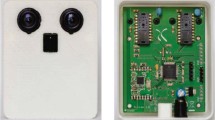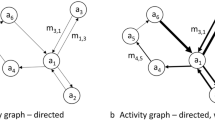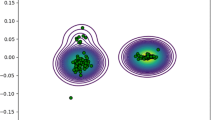Abstract
In this paper we present an approach to analyzing the social behaviors that occur in a typical office space. We describe a system consisting of over 200 motion sensors connected in a wireless network observing a medium-sized office space populated with almost 100 people for a period of almost a year. We use a tracklet graph representation of the data in the sensor network, which allows us to efficiently evaluate gross patterns of office-wide social behavior of its occupants during expected seasonal changes in the workforce as well as unexpected social events that affect the entire population of the space. We present our experiments with a method based on Kullback-Leibler metric applied to the office activity modelled as a Markov process. Using this approach we detect gross deviations of short term office-wide behavior patterns from previous long-term patterns spanning various time intervals. We compare detected deviations to the company calendar and find and provide some quantitative analysis of the relative impact of those disruptions across a range of temporal scales. We also present a favorable comparison to results achieved by applying the same analysis to email logs.
Preview
Unable to display preview. Download preview PDF.
Similar content being viewed by others
References
Allen, T.: Architecture and communication among product development engineers. In: Proceedings of the Engineering Management Society, pp. 153–158. IEEE, Los Alamitos (2000)
Reynolds, C., Picard, R.: Evaluation of affective computing systems from a dimensional metaethical position. In: First Augmented Cognition International Conference, Las Vegas, NV (2005)
Ivanov, Y., Sorokin, A., Wren, C., Kaur, I.: Tracking people in mixed modality systems. Visual Communications and Image Processing, EI123., IS&T/SPIE (2007)
Scott, J.P.: Social Network Analysis: A Handbook. SAGE Publications, Thousand Oaks (1991)
Tichy, N.M., Tushman, M.L., Fombrun, C.: Social network analysis for organizations. The Academy of Management Review 27 (1979)
Tyler, J., Wilkinson, D., Huberman, B.A: Email as Spectroscopy: Automated Discovery of Community Structure within Organizations. In: Communities and Technologies, Kluwer Academic, Dordrecht (2003)
van Alstyne, M., Zhang, J.: Emailnet: A system for automatically mining social networks from organizational email communication. In: Annual Conference of the North American Association for Computational Social and Organizational Sciences (2003)
McCallum, A., Corrada-Emmanuel, A., Wang, X.: Topic and role discovery in social networks. In: 19th Joint Conference on Artificial Intelligence (2005)
Culotta, A., Bekkerman, R., McCallum, A.: Extracting social networks and contact information from email and the web. In: Conference on Email and Spam (2004)
Aipperspach, R., Cohen, E., Canny, J.: Modeling human behavior from simple sensors in the home. In: Proceedings Of The IEEE Conference On Pervasive Computing (2006)
Wilson, D.H., Atkeson, C.: Simultaneous tracking & activity recognition (star) using many anonymous, binary sensors. In: The Third International Conference on Pervasive Computing, pp. 62–79 (2005)
Munguia Tapia, E., Intille, S.S., Lopez, L., Larson, K.: The design of a portable kit of wireless sensors for naturalistic data collection. In: Fishkin, K.P., Schiele, B., Nixon, P., Quigley, A. (eds.) PERVASIVE 2006. LNCS, vol. 3968, Springer, Heidelberg (2006)
Abowd, G., Bobick, A., Essa, I., Mynatt, E., Rogers, W.: The aware home: Developing technologies for successful aging. In: Proceedings of AAAI Workshop on Automation as a Care Giver (2002)
Eagle, N., Pentland, A.: Reality mining: Sensing complex social systems. Personal and Ubiquitous Computing 10(4), 255–268 (2006)
Choudhury, T., Pentland, A.: Characterizing social networks using the sociometer. In: Proceedings of the North American Association of Computational Social and Organizational Science (NAACSOS) (2004)
Reynolds, C.J., Wren, C.R.: Worse is better for ambient sensing. In: Pervasive: Workshop on Privacy, Trust and Identity Issues for Ambient Intelligence (2006)
Athans, M., Chang, C.B.: Adaptive estimation and parameter identification using multiple model estimation algorithm. Technical Report, 1976-28, Massachusetts Institute of Technology Lincoln Laboratory, Lexington, Massachusetts, USA, Group 32 (1976)
Moeslund, T.B., Granum, E.: A survey of computer vision-based human motion capture. Computer Vision and Image Understanding 81, 231–268 (2001)
Stark, H., Woods, J.W: Probability, Random Processes, and Estimation Theory for Engineers, 2nd edn. Prentice Hall, Englewood Cliffs (1994)
Rached, Z., Alajaji, F., Campbell, L.L.: The kullback-leibler divergence rate between markov sources. IEEE Transactions on Information Theory 50(5) (2004)
Kuhl, M.E., Wilson, J.R.: Modeling and simulating poisson processes having trends or nontrigonometric cyclic effects. European Journal of Operational research 133, 566–582 (2001)
Consolvo, S., Walker, M.: Using the experience sampling method to evaluate ubicomp applications. In: Pervasive Computing, pp. 24–31. IEEE Computer Society Press, Los Alamitos (2003)
Bernard, H.R., Killworth, P.D: Informant accuracy in social network data ii. Human Communications Research 4(1), 3–18 (1977)
Author information
Authors and Affiliations
Editor information
Rights and permissions
Copyright information
© 2007 Springer-Verlag Berlin Heidelberg
About this paper
Cite this paper
Wren, C.R., Ivanov, Y.A., Kaur, I., Leigh, D., Westhues, J. (2007). SocialMotion: Measuring the Hidden Social Life of a Building. In: Hightower, J., Schiele, B., Strang, T. (eds) Location- and Context-Awareness. LoCA 2007. Lecture Notes in Computer Science, vol 4718. Springer, Berlin, Heidelberg. https://doi.org/10.1007/978-3-540-75160-1_6
Download citation
DOI: https://doi.org/10.1007/978-3-540-75160-1_6
Publisher Name: Springer, Berlin, Heidelberg
Print ISBN: 978-3-540-75159-5
Online ISBN: 978-3-540-75160-1
eBook Packages: Computer ScienceComputer Science (R0)




